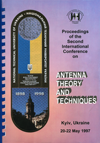On principles of antenna motion compensation in airborne MTI radars
DOI:
https://doi.org/10.1109/ICATT.1997.1235134Abstract
An airborne radar antenna motion makes worse the clatter correlation and so Moving Target Indication (MTI) performance. Antenna Motion Compensation (AMC) is possible by means of Time-Space (TS) MTI filters such as Displaced Phase Center Antennas (DPCA [1]) or TS Adaptive Arrays (TSAA [2]). In the known AMC theory main objects of interest are DPCA patterns and TSAA processing convergence properties but AMC reasonable borders remain unknown. In this article more general view on the AMC problem is delivered using transmit and receive aperture weight functions that define all the clutter TS modulation, correlation and optimum MTI processing. Our purpose is to clear AMC principles, use bounds and conditions of antenna minimal complicity.References
Skolnik, M.I. (ed.). The Radar Handbook. N.Y.: McGraw-Hill, 1970, Vol. 3, Ch. 6.
Brennan, L.; Malletz, J.; Reed, I. Adaptive arrays in airborne MTI radar. IEEE Trans. on Antennas and Propagation, Sept. 1976, Vol. AP-24, No. 5, p. 607-615.
Litvinov, V.V. On potential and real performance of coherent pulse MTI systems in search radars at non-ambiguity ranging. Radiotekhnika, 1996, No. 100, p. 158-173.
Litvinov, V.V. Radar early warning aircrafts : main decisions’ choice problem. Nauka i Oborona, 1994, No. 3, p. 3-9.
Published
1997-05-24
Issue
Section
AA, AAA, smart antennas and signal processing

